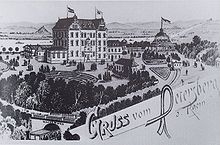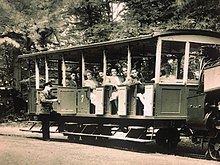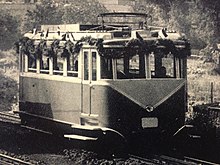Petersbergbahn
| Petersbergbahn | |||||||||||||||||||||||||||||||||||||||||||||
|---|---|---|---|---|---|---|---|---|---|---|---|---|---|---|---|---|---|---|---|---|---|---|---|---|---|---|---|---|---|---|---|---|---|---|---|---|---|---|---|---|---|---|---|---|---|
|
Former engine shed (back) of the Petersbergbahn (2013)
| |||||||||||||||||||||||||||||||||||||||||||||
| Route length: | 1.75 km | ||||||||||||||||||||||||||||||||||||||||||||
| Gauge : | 1000 mm ( meter gauge ) | ||||||||||||||||||||||||||||||||||||||||||||
| Maximum slope : | 260 ‰ | ||||||||||||||||||||||||||||||||||||||||||||
| Rack system : | Riggenbach | ||||||||||||||||||||||||||||||||||||||||||||
|
|||||||||||||||||||||||||||||||||||||||||||||
The Petersberg Railway was a narrow gauge cog railway , she married on 20 April 1889 to 21 September 1958 for Koenigswinter am Rhein with the peak of the Seven Mountains situated Peter Berg .
history
The external reason was the construction of a hotel on the Petersberg. In meter gauge railway running had on the extension to the station Koenigswinter a length of 1.750 kilometers and overcame gradients of up to 26%. Because of this extreme gradient (steepest cogwheel railway in Germany), the Petersbergbahn received a special operating permit, as the Riggenbach rack and pinion system in Germany was and is only permitted up to 25% maximum gradient for cogwheel railways (does not apply to funiculars). The route also had a very flat section, so that on this short section of the route, coupling of the individual vehicles was permitted when driving up and down the mountain. The coupling bracket was always operated by the stoker of the geared locomotive. This flat section of the route was located between the valley train station and just before the greatest incline. If the rack railway locomotive was exchanged for a locomotive from the Drachenfelsbahn , this coupling bracket was removed and installed in the newly stationed locomotive. The front buffer of the new cogwheel locomotive has also been moved down by around 20 cm. This happened because all Vorstellwagen the Petersberg train had another buffer height above the rack, than those of Drachenfelsbahn. Halfway up the route had a passing point for the rare train crossings. The first operator was the Petersberger Zahnradbahn AG . The train compositions always looked like this: a cogwheel locomotive with a passenger car or a cogwheel locomotive with a freight car. From around 1948 to around 1953, two steam locomotives were again stationed on the Petersbergbahn at the same time.
In 1913 Ferdinand Mülhens , boss and owner of the 4711 house in Cologne, bought the hotel and the railway. Under his leadership, the Petersbergbahn was extended and the valley station was relocated to the state train station in Königswinter. 1914 approved , the completion of this project was delayed by the outbreak of the First World War to the national police decrease in 1921. 1923 merged Mülhens end of March, the Petersberg web with the neighboring Drachenfelsbahn to cable cars in the Siebengebirge AG , after quite a few years, owners of both rack railways in the Seven Mountains was.
During the First World War , the Petersbergbahn did not operate from April 16, 1915 to May 21, 1920. During the Second World War - in 1944 - the Petersbergbahn was closed. Operations resumed after the end of the war in 1947. From October 3, 1949, the Petersbergbahn operated exclusively for employees of the Allied High Commission based on the Petersberg , around 500 journeys a month had to be made.
On September 21, 1958, the Petersbergbahn stopped operating. The serious accident on the neighboring Drachenfelsbahn a week earlier had, contrary to many different sources, no influence on the closure of the Petersbergbahn. The regular cessation of operations for economic reasons was planned for the end of the 1958 season anyway. The local press reported that after the accident on the Drachenfelsbahn, numerous day trippers switched to the Petersbergbahn in the last days of September 1958, so operations continued unabated. However, this did not prevent the shutdown that followed shortly thereafter. Subsequently, the operation of the Petersberg was taken over by buses .
The track systems remained in place until the mid-1970s, after which they were dismantled. It was not until 1975 that the Petersbergbahn was legally shut down, i. H. dedicated . In 1992 the covered platform in Königswinter was demolished. The three-tier locomotive and wagon shed including the portal crane, maintenance pits and rack and pinion tracks on the border to the area of the former Lemmerz works have been preserved. In addition, parts of the original metal fence at the valley station and the remains of the Am Dömchen maintenance station have been preserved. On the Petersberg today only a small memorial on the former terrain of the mountain station and the road bridge at the summit that is still partially preserved on one side remind of the former railway.
Vehicle list
Steam locomotives
| Road no. | design type | Manufacturer | Construction year | Serial number | Petersbergbahn | further use | photo |
|---|---|---|---|---|---|---|---|
| 1 "Königswinter" | 2 / a-n2t | ME | 1888 | 2308 | 1888-before 1929 ++ 1926-29 | ||
| 2 "Petersberg" | 2 / a-n2t | ME | 1888 | 2309 | 1888-before 1929 ++ 1926-29 | ||
| 4th | (2) 1 '/ b-h2t | ME | 1928 | 4220 | 1951–1958 ++ 1958? | 1928–1951 Drachenfels Railway | |
| 5 | (2) 1 '/ b-h2t | ME | 1926 | 4161 | 19xx-1938 | 1926-19xx Drachenfelsbahn; 1938–1939 Niederwaldbahn , Rüdesheim as "Saar"; 1939–1952 ++ 1952 | |
| 1" | (2) 1 '/ b-h2t | ME | 1929 | 4225 | 1938? -1958 ++ 1958? | 1929–1938? Drachenfelsbahn |
Presentation car
| Road no. | design type | Manufacturer | Construction year | Serial number | Petersbergbahn | further use | photo |
|---|---|---|---|---|---|---|---|
| 1 | ME | 1889 | 1889-1958 | 19xx redrawing in No. 7 of the mountain railways in the Siebengebirge | |||
| 2 | ME | 1889 | 1889-1958 | 1949 Conversion to a closed car body with steam heating for official traffic of the Allied High Commission to Petersberg, redesignated as No. 8 of the mountain railways in the Siebengebirge | |||
| 3 " | 1884 | 1950–1953 +1953 due to renovation; 1963 | 1884–1950 Niederwaldbahn No. 6, Rüdesheim; 1950 and 1953 Drachenfelsbahn; 1950 Conversion to a closed car body with steam heating for official traffic of the Allied High Commission to Petersberg; 1953 conversion to ET I +1963; 1963 parked at the disused Petersbergbahn; 1963-? as a building shack in Bonn-Beuel |
Freight wagons
| Road no. | design type | Manufacturer | Construction year | Serial number | Petersbergbahn | further use | photo |
|---|---|---|---|---|---|---|---|
| (1) | Low side car | DIY? | 1883 | ? | 1889-1957 | from 1883 also at the Drachenfelsbahn, among other things as a workshop trolley i. E .; 2018 i. E. ibid | |
| (2) | Low side car | ME | 1889 | ? | 1889-1958 | 1958 at the Drachenfelsbahn as a workshop car ?; Remaining unclear, possibly identical to (1) |
Others
- Only one presentation car was allowed to be transported per train journey.
- The length of the Riggenbach ladder racks was 3.00 m each (manufacturer's standard size).
- The rungs or webs of the ladder racks were riveted in the early years and later welded in.
- Pentecost 1929: A cogwheel locomotive (locomotive 1 or 2) derailed on the descent. Gearbox damage was suspected to be the cause. However, this has never been officially verified.
- Locomotives 1 and 2 were scrapped between 1926 and 1929.
- Around 1950 two steam locomotives (locomotive 1 '' & locomotive 4) with two converted presentation cars (presentation car No. 8 & formerly No. 3 "of the Drachenfelsbahn) were stationed at the Petersbergbahn for passenger traffic, as well as the open presentation car No. 7.
- Valley station with three rack and pinion turnouts and a transfer table to the locomotive shed.
- A passing point with two rack and pinion turnouts and a turnout stand, this was later transferred to the Drachenfelsbahn, since from around 1952 there were no more train crossings in the passing point. Other sources report from 1938.
- Mountain station: a switch with two butt tracks, with a platform, a small station building.
- 1919–1920, relocation of the valley station and the mountain station, new route length 1750 m: the route in the direction of the state train station was extended by 400 m, at the same time the route with the mountain station was relocated by around 50 m but not shortened. Linked to this was the kilometer indication that is still valid today.
- After the ET I was retired from the Drachenfelsbahn, the railcar was parked in the valley station of the Petersbergbahn. It was later sold as a construction trailer.
literature
- Angelika Schyma : City of Königswinter. (= Monument topography Federal Republic of Germany , monuments in the Rhineland. Volume 23.5). Rheinland-Verlag, Cologne 1992, ISBN 3-7927-1200-8 , p. 174.
Web links
- History of the Petersbergbahn
- Description and pictures
- Mountain railways in the Siebengebirge
- Relics of the railway on salzwiesenbahn.de
- Routing measuring table sheet from 1942 ( Deutsche Fotothek )
- Petersbergbahn: Route pictures - a gallery with over 70 photos, drawings and documents
- Petersbergbahn 1889–1958 - a gallery on the history of the Petersbergbahn with over 50 photos, timetables, drawings and documents
Individual evidence
- ↑ Winfried Biesing: The Petersberg. From the Fliehburg to the residence for state guests . Heel Verlag, Königswinter 1990, ISBN 3-89365-186-1 , pp. 53, 56/57.
- ^ Helmut Vogt : Guardians of the Bonn Republic: The Allied High Commissioners 1949–1955. Verlag Ferdinand Schöningh, Paderborn 2004, ISBN 3-506-70139-8 , p. 47.







